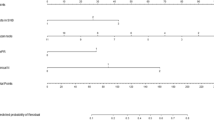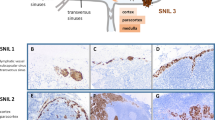Abstract
The sentinel lymph node (SLN) is the lymph node that represents the 'gate-keeper' of the lymphatic basin; it is the first node to receive lymphatic drainage from the site of the primary tumor. SLN biopsy is a staging procedure and should be considered as such; it is not meant to be a therapeutic operation. The SLN can be mapped and biopsied using tracer agents (e.g. radiolabelled colloid and/or vital blue dye), which are injected around the primary tumor site. Pathologic analysis of the SLN using a combination of serial sectioning of the node, standard hematoxylin and eosin staining, and immunohistochemistry decreases the false-negative rate compared with traditional nodal processing. SLN biopsy is associated with lower morbidity than full lymphadenectomy. The SLN technique accurately reflects the metastatic status of the regional lymph-node basin; recurrent nodal disease in the mapped basin is rare following a tumor-free SLN biopsy result. The objectives of this review are to provide a current and concise overview of the current literature on SLN biopsy and describe its role in clinical oncology.
This is a preview of subscription content, access via your institution
Access options
Subscribe to this journal
Receive 12 print issues and online access
$209.00 per year
only $17.42 per issue
Buy this article
- Purchase on Springer Link
- Instant access to full article PDF
Prices may be subject to local taxes which are calculated during checkout




Similar content being viewed by others
References
Wong JH et al. (1991) Lymphatic drainage of skin to a sentinel lymph node in a feline model. Ann Surg 214: 637–641
Morton DL et al. (1992) Technical details of intraoperative lymphatic mapping for early stage melanoma. Arch Surg 127: 392–399
Gershenwald JE et al. (1999) Multi-institutional melanoma lymphatic mapping experience: the prognostic value of sentinel lymph node status in 612 stage I or II melanoma patients. J Clin Oncol 17: 976–983
Gershenwald JE et al. (2000) Role for lymphatic mapping and sentinel lymph node biopsy in patients with thick (≥4 mm) primary melanoma. Ann Surg Oncol 7: 160–165
McMasters KM et al. (2000) Sentinel lymph node biopsy for breast cancer: a suitable alternative to routine axillary dissection in multi-institutional practice, when optimal technique is used. J Clin Oncol 18: 2560–2566
McMasters KM et al. (2004) Lessons learned from the Sunbelt Melanoma Trial. J Surg Oncol 86: 212–223
American Cancer Society (2004) Cancer Facts and Figures, 2004 1–58. Atlanta: American Cancer Society
Balch CM et al. (2001) Prognostic factors analysis of 17,600 melanoma patients: validation of the American Joint Committee on Cancer melanoma staging system. J Clin Oncol 19: 3622–3634
McMasters KM et al. (2001) Factors that predict the presence of sentinel lymph node metastasis in patients with melanoma. Surgery 130: 151–156
Ross MI et al. (1993) Selective lymphadenectomy: emerging role for lymphatic mapping and sentinel node biopsy in the management of early stage melanoma. Semin Surg Oncol 9: 219–223
Uren RF et al. (1993) Lymphoscintigraphy in high-risk melanoma of the trunk: predicting draining node groups, defining lymphatic channels and locating the sentinel node. J Nucl Med 34: 1435–1440
Reintgen D et al. (1994) The orderly progression of melanoma nodal metastases. Ann Surg 220: 759–767
Gershenwald JE et al. (1998) Patterns of recurrence following a negative sentinel lymph node biopsy in 243 patients with stage I or II melanoma. J Clin Oncol 16: 2253–2260
Gadd MA et al. (1999) Outcome of patients with melanoma and histologically negative sentinel lymph nodes. Arch Surg 134: 381–387
Essner R et al. (1999) Efficacy of lymphatic mapping, sentinel lymphadenectomy, and selective complete lymph node dissection as a therapeutic procedure for early-stage melanoma. Ann Surg Oncol 6: 442–449
Otley CC and Zitelli JA (2000) Review of sentinel lymph node biopsy and systemic interferon for melanoma: promising but investigational modalities. Dermatol Surg 26: 177–180
Thomas JM and Patocskai EJ (2000) The argument against sentinel node biopsy for malignant melanoma. BMJ 321: 3–4
Jimenez RE et al. (2005) Prognostic implications of multiple lymphatic basin drainage in patients with truncal melanoma. J Clin Oncol 23: 518–524
Stitzenberg KB et al. (2004) Indications for lymphatic mapping and sentinel lymphadenectomy in patients with thin melanoma (Breslow thickness ≤1.0 mm). Ann Surg Oncol 11: 900–906
Carlson GW et al. (2003) Sentinel lymph node mapping for thick (≥4 mm) melanoma: should we be doing it? Ann Surg Oncol 10: 408–415
Gaynor R et al. (1981) S100 protein: a marker for human malignant melanomas? Lancet 1: 869–871
Ordonez NG et al. (1988) Comparison of HMB-45 monoclonal antibody and S-100 protein in the immunohistochemical diagnosis of melanoma. Am J Clin Pathol 90: 385–390
Messina JL and Glass LF (1997) Pathologic examination of the sentinel lymph node. J Fla Med Assoc 84: 153–156
Roaten JB et al. (2005) Identifying risk factors for complications following sentinel lymph node biopsy for melanoma. Arch Surg 140: 85–89
Estourgie SH et al. (2004) High incidence of in-transit metastases after sentinel node biopsy in patients with melanoma. Br J Surg 91: 1370–1371
Kretschmer L et al. (2005) Sentinel lymphonodectomy does not increase the risk of loco-regional cutaneous metastases of malignant melanomas. Eur J Cancer 41: 531–538
Gershenwald JE et al. (2000) Regional nodal basin control is not compromised by previous sentinel lymph node biopsy in patients with melanoma. Ann Surg Oncol 7: 226–231
McMasters KM et al. (2002) Frequency of nonsentinel lymph node metastasis in melanoma. Ann Surg Oncol 9: 137–141
Lee JH et al. (2004) Factors predictive of tumor-positive nonsentinel lymph nodes after tumor-positive sentinel lymph node dissection for melanoma. J Clin Oncol 22: 3677–3684
McMasters KM (2004) What good is sentinel lymph node biopsy for melanoma if it does not improve survival? Ann Surg Oncol 11: 810–812
Carter CL et al. (1989) Relation of tumor size, lymph node status, and survival in 24,740 breast cancer cases. Cancer 63: 181–187
Fisher ER et al. (1993) Pathologic findings from the National Surgical Adjuvant Breast Project protocol B-06. 10-year pathologic and clinical prognostic discriminants. Cancer 71: 2507–2514
Krag DN et al. (1993) Surgical resection and radiolocalization of the sentinel lymph node in breast cancer using a gamma probe. Surg Oncol 2: 335–339
Giuliano AE et al. (1994) Lymphatic mapping and sentinel lymphadenectomy for breast cancer. Ann Surg 220: 391–398
Albertini JJ et al. (1996) Lymphatic mapping and sentinel node biopsy in the patient with breast cancer. JAMA 276: 1818–1822
McMasters KM et al. (2000) Preoperative lymphoscintigraphy for breast cancer does not improve the ability to identify axillary sentinel lymph nodes. Ann Surg 231: 724–731
Chagpar AB et al. Effect of lymphoscintigraphy drainage patterns on sentinel lymph node biopsy in patients with breast cancer. Am J Surg, in press
Giuliano AE (1996) Sentinel lymphadenectomy in primary breast carcinoma: an alternative to routine axillary dissection. J Surg Oncol 62: 75–77
Martin RC et al. (2005) Clinicopathologic factors associated with false-negative sentinel lymph-node biopsy in breast cancer. Ann Surg 241: 1005–1015
Chagpar AB et al. (2005) Factors predicting failure to identify a sentinel node in breast cancer. Surgery 138: 56–63
McMasters KM et al. (2001) Dermal injection of radioactive colloid is superior to peritumoral injection for breast cancer sentinel lymph node biopsy: results of a multiinstitutional study. Ann Surg 233: 676–687
Klimberg VS et al. (1999) Subareolar versus peritumoral injection for location of the sentinel lymph node. Ann Surg 229: 860–864
Chagpar A et al. (2004) Validation of subareolar and periareolar injection techniques for breast sentinel lymph node biopsy. Arch Surg 139: 614–618
Wong SL et al. (2001) Accuracy of sentinel lymph node biopsy for patients with T2 and T3 breast cancers. Am Surg 67: 522–526
Nason KS et al. (2000) Increased false negative sentinel node biopsy rates after preoperative chemotherapy for invasive breast carcinoma. Cancer 89: 2187–2194
Haid A et al. (2001) Is sentinel lymph node biopsy reliable and indicated after preoperative chemotherapy in patients with breast carcinoma? Cancer 92: 1080–1084
Tamhane R et al. (2002) The clinical significance of cytokeratin-positive cells in lymph nodes at the time of mastectomy from patients with ductal carcinoma in situ. Ann Surg Oncol 9: 999–1003
White RL et al. (2004) Update on the NSABP and ACOSOG breast cancer sentinel node trials. Am Surg 70: 420–424
Singletary SE et al. (2002) Revision of the American Joint Committee on Cancer staging system for breast cancer. J Clin Oncol 20: 3628–3636
Albertini JJ et al. (1996) Intraoperative radio-lympho-scintigraphy improves sentinel lymph node identification for patients with melanoma. Ann Surg 223: 217–224
Sumner WE Jr et al. (2002) Implications of lymphatic drainage to unusual sentinel lymph node sites in patients with primary cutaneous melanoma. Cancer 95: 354–360
Chao C et al. (2004) Correlation between prognostic factors and increasing age in melanoma. Ann Surg Oncol 11: 259–264
Veronesi U et al. (1999) Sentinel lymph node biopsy and axillary dissection in breast cancer: results in a large series. J Natl Cancer Inst 91: 368–373
Quan ML et al. (2002) Biology of lymphatic metastases in breast cancer: lessons learned from sentinel node biopsy. Ann Surg Oncol 9: 467–471
Tafra L et al. (2001) Multicenter trial of sentinel node biopsy for breast cancer using both technetium sulfur colloid and isosulfan blue dye. Ann Surg 233: 51–59
Bergkvist L et al. (2001) Multicentre study of detection and false-negative rates in sentinel node biopsy for breast cancer. Br J Surg 88: 1644–1648
McMasters KM et al. (2001) Defining the optimal surgeon experience for breast cancer sentinel lymph node biopsy: a model for implementation of new surgical techniques. Ann Surg 234: 292–299
Acknowledgements
We would like to thank the University of Louisville and the Center for Advanced Surgical Technologies of Norton Hospital for their support.
Author information
Authors and Affiliations
Corresponding author
Ethics declarations
Competing interests
K McMasters has been on the Speaker's bureau for Schering Oncology Biotech and Ethicon, and has served as a consultant to National Genetics Corporation, Veridex, and Ethicon. The other authors declared they have no competing interests.
Rights and permissions
About this article
Cite this article
Scoggins, C., Chagpar, A., Martin, R. et al. Should sentinel lymph-node biopsy be used routinely for staging melanoma and breast cancers?. Nat Rev Clin Oncol 2, 448–455 (2005). https://doi.org/10.1038/ncponc0293
Received:
Accepted:
Issue Date:
DOI: https://doi.org/10.1038/ncponc0293



